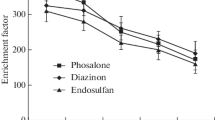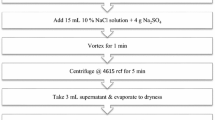Abstract
The sample preparation methods such as the solid-phase microextraction (SPME) and the single-drop microextraction (SDME) for preconcentration of some endocrine disruptor chemicals (EDCs) leaching from baby milk feeding bottles were developed. Afterwards, all analytes were determined by using the GC-MS technique. The parameters affecting extraction efficiency of both methods including fiber coating, extraction time, extraction temperature, salting-out effect, desorption time, organic solvent, drop volume, pH of the solution, and stirring rate were also investigated. Under the optimum extraction conditions, the results from the developed methods revealed that the analysis time used was somewhat short (<8 min). The detection limits was low (LOD, 0.02–0.12 μg/mL for direct-SPME and 0.07–0.17 μg/mL for direct-SDME). The precision was slightly satisfactory (RSD, <5.9% of intra-day, <7.9% of inter-day for direct-SPME and <4.3% of intra-day, <4.7% of inter-day for direct-SDME). Moreover, the recoveries in both techniques were slightly high (85–102% for direct-SPME and 84–103% for direct-SDME). In this regard, both direct-SPME and direct-SDME methods could be used as alternative ways for the sensitive determination of some EDCs. Besides, the simple, rapid, and efficient features of the proposed method were demonstrated by the analysis of these compounds in aqueous solution.














Similar content being viewed by others
References
Arisseto AP, Vicente E, Furlani RPZ, Pereira ALD, Toledo MCF (2013) Development of a headspace-solid phase microextraction-gas chromatography/mass spectrometry (HS-SPME-GC/MS) method for the determination of benzene in soft drinks. Food Anal Methods 6:1379–1387
Bagheri H, Saraji M (2003) Conductive polymers as new media for solid-phase extraction: isolation of chlorophenols from water sample. J Chromatogr A 986:111–119
Basheer C, Lee HK (2004) Analysis of endocrine disrupting alkylphenols, chlorophenols and bisphenol-A using hollow fiber-protected liquid-phase microextraction coupled with injection port-derivatization gas chromatography–mass spectrometry. J Chromatogr A 1057:163–169
Ben Fredj S, Nobbs J, Tizaoui C, Monser L (2015) Removal of estrone (E1), 17β-estradiol (E2), and 17α-ethinylestradiol (EE2) from wastewater by liquid–liquid extraction. Chem Eng J 262:417–426
Braun P, Moeder M, Schrader S, Popp P, Kuschk P, Engewald W (2003) Trace analysis of technical nonylphenol, bisphenol A and 17α-ethinylestradiol in wastewater using solid-phase microextraction and gas chromatography–mass spectrometry. J Chromatogr A 988:41–51
Buchholz KD, Pawliszyn J (1994) Optimization of solid-phase microextraction conditions for determination of phenols. Anal Chem 66:160–167
Campillo N, Penalver R, Cordoba MH (2006) Evaluation of solid-phase microextraction conditions for the determination of chlorophenols in honey samples using gas chromatography. J Chromatogr A 1125:31–37
del Olmo M, Zafra A, Suarez B, Casado AG, Taoufiki J, Vilchez JL (2005) Use of solid-phase microextraction followed by on-column silylation for determining chlorinated bisphenol A in human plasma by gas chromatography–mass spectrometry. J Chromatogr B 817:167–172
Faraji M, Noorani M, Sahneh BN (2016) Quick, easy, cheap, effective, rugged, and safe method followed by ionic liquid-dispersive liquid–liquid microextraction for the determination of trace amount of bisphenol A in canned foods. Food Anal Methods. doi:10.1007/s12161-016-0635-y
Helaleh MIH, Tanaka K, Fujii S, Korenaga T (2001) GC/MS determination of phenolic compounds in soil samples using soxhlet extraction and derivatization techniques. Anal Sci 17:1225–1227
ICH (1996) Harmonised tripartite guideline, validation of analytical procedures: text and methodology Q2(R1), Current Step 4 version (complementary guideline on methodology dated 6 November incorporated in November 2005)
Jeannot MA, Cantwell FF (1996) Solvent microextraction into a single drop. Anal Chem 68:2236–2240
Ke Y, Li W, Wang Y, Hao X, Jiang R, Zhub F, Ouyang G (2014) Comparison of fully-automated headspace single drop microextraction and headspace solid phase microextraction techniques for rapid analysis of no. 6 solvent residues in edible oil. Microchem J 117:187–193
Lancas FM, Olivares IRB, Alves PM (2007) Development, validation and application of a method to analyze phenols in water samples by solid phase micro extraction-gas chromatography-flame ionization detector. J Environ Sci Health Part B 42:491–498
Lopez-Darias J, German-Hernandez M, Pino V, Afonso AM (2010) Dispersive liquid-liquid microextraction versus single-drop microextraction for the determination of several endocrine-disrupting phenols from seawaters. Talanta 80:1611–1618
Lopez-Darias J, Pino V, Ayala JH, Afonso AM (2011) In-situ ionic liquid-dispersive liquid-liquid microextraction method to determine endocrine disrupting phenols in seawaters and industrial effluents. Microchim Acta 14:213–222
Mahugo-Santana C, Sosa-Ferrera Z, Torres-Padrón ME, Santana-Rodríguez JJ (2011) Application of new approaches to liquid-phase microextraction for the determination of emerging pollutants. TrAC-Trend Anal Chem 30:731–748
Miller JC, Miller JN (1993) Statistics for analytical chemistry, 3rd edn. Ellis Horwood, New York
Ouyang G, Vuckovic D, Pawliszyn J (2011) Nondestructive sampling of living systems using in vivo solid-phase microextraction. Chem Rev 111:2784–2814
Pawliszyn J (1997) Solid phase microextraction: theory and practice. Wiley—VCH, New York, p 275
Pena-Pereira F, Lavilla I, Bendicho C (2010) Liquid-phase microextraction techniques within the framework of green chemistry. TrAC-Trend Anal Chem 29:617–628
Pereira dos Anjos J, Andrade de JB (2014) Determination of nineteen pesticides (organophosphates, organochlorine, pyrethroids, carbamate, thiocarbamate and strobilurin) in coconut water SDME/GC–MS. Microchem J 112:119–126
Psillakis E, Kalogerakis N (2001) Solid-phase microextraction versus single-drop microextraction for the analysis of nitroaromatic explosives in water samples. J Chromatogr A 938:113–120
Regueiro J, Becerril E, Garcia-Jares C, Llompart M (2009) Trace analysis of parabens triclosan and related chlorophenols in water by headspace solid-phase microextraction with in situ derivatization and gas chromatography-tandem mass spectrometry. J Chromatogr A 1216:4693–4702
Ribeiro A, Neves MH, Almeida MF, Alves A, Santos L (2002) Direct determination of chlorophenols in landfill leachates by solid-phase microextraction–gas chromatography–mass spectrometry. J Chromatogr A 975:267–274
Sadeghi M, Nematifar Z, Fattahi N, Pirsaheb M, Shamsipur M (2016) Determination of bisphenol a in food and environmental samples using combined solid-phase extraction–dispersive liquid–liquid microextraction with solidification of floating organic drop followed by HPLC. Food Anal Methods 9:1814–1824
Sarafraz-Yazdi A, Amiri A (2001) Liquid-phase microextraction. Trends Anal Chem 29(1):1–14
Saraji M, Bakhshi M (2005) Determination of phenols in water samples by single-drop microextraction followed by in-syringe derivatization and gas chromatography–mass spectrometric detection. J Chromatogr A 1098:30–36
Sarrion MN, Santos FJ, Galceran MT (2002) Determination of chlorophenols by solid-phase microextraction and liquid chromatography with electrochemical detection. J Chromatogr A 947:155–165
Song X, Li J, Chen L, Cai Z, Liao C, Peng H, Xiong H (2012) Determination of polychlorinated biphenyls in seawater using headspace solid-phase microextraction coupled with gas chromatography-mass spectrometry with the aid of experimental design. J Braz Chem Soc 23:132–141
Tankeviciute A, Kazlauskas R, Vickackaite V (2001) Headspace extraction of alcohols into a single drop. Analyst 126:1674–1677
Wang Y, Li Y, Zhang J, Xu S, Yang S, Sun C (2009) A novel fluorinated polyaniline based solid-phase microextraction coupled with gas chromatography for quantitative determination of polychlorinated biphenyls in water samples. Anal Chim Acta 646:78–84
Wardencki W, Curylo J, Namiesnik J (2007) Trends in solventless sample preparation techniques for environmental analysis. J Biochem Biophys Methods 70:275–288
Wu YY, Yang CX, Yan XP (2014) Fabrication of metal-organic framework MIL-88B films on stainless steel fibers for solid-phase microextraction of polychlorinated biphenyls. J Chromatogr A 1334:1–8
Wu H, Li G, Liu S, Hu N, Geng D, Chen G, Sun Z, Zhao X, Xia L, You J (2016) Monitoring the contents of six steroidal and phenolic endocrine disrupting chemicals in chicken, fish and aquaculture pond water samples using pre-column derivatization and dispersive liquid–liquid microextraction with the aid of experimental design methodology. Food Chem 192:98–106
Ye C, Zhou Q, Wang X (2007) Improved single-drop microextraction for high sensitive analysis. J Chromatogr A 1139:7–13
Zgoła-Grześkowiak A (2015) Magnetic retrieval of ionic liquid formed during in situ metathesis dispersive liquid–liquid microextraction–preconcentration of selected endocrine disrupting phenols from an enlarged sample volume. Anal Methods 7:1076–1084
Zhang M, Huang J, Wei C, Yu B, Yang X, Chen X (2008) Mixed liquids for single-drop microextraction of organochlorine pesticides in vegetables. Talanta 74:599–604
Zhao L, Lee HK (2001) Determination of phenols in water using liquid phase microextraction with back extraction combined with high-performance liquid chromatography. J Chromatogr A 931:95–105
Zhou Q, Hao Y, Xie G (2011) Determination of bisphenol A, 4-n-nonylphenol, and 4-tert-octylphenol by temperature-controlled ionic liquid dispersive liquid phase microextraction combined with high performance liquid chromatography-fluorescence detector. Talanta 85:1598–1602
Zhu F, Xu J, Ke Y, Huang S, Zeng F, Luan T, Ouyang G (2013) Applications of in vivo and in vitro solid-phase microextraction techniques in plant analysis: a review. Anal Chim Acta 794:1–14
Acknowledgements
I would like to give special thanks to the Chemistry program, Pibulsongkram Rajabhat University and Department of Chemistry, Faculty of Science, Chiang Mai University for instrument support along this research. I would also like to thank the Center of Excellent for Innovation in Chemistry (PERCH-CIC) and Pibulsongkram Rajabhat University for financial support. Finally, I would like to thank all the staffs who made it possible to complete this research.
Author information
Authors and Affiliations
Corresponding author
Ethics declarations
Conflict of Interest
Yuttasak Chammui declares that he has no conflict of interest.
Ethical Approval
This article does not contain any studies on human or animal subjects.
Informed Consent
Not applicable.
Rights and permissions
About this article
Cite this article
Chammui, Y. Rapid Analysis of some Endocrine Disruptor Chemicals Leaching from Baby Milk Feeding Bottles Using SPME and SDME Techniques. Food Anal. Methods 10, 2607–2618 (2017). https://doi.org/10.1007/s12161-017-0825-2
Received:
Accepted:
Published:
Issue Date:
DOI: https://doi.org/10.1007/s12161-017-0825-2




